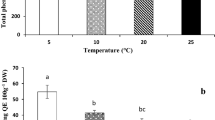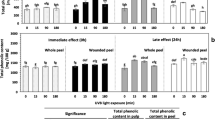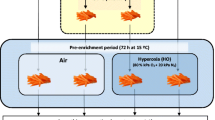Abstract
Phenolic compounds are phytochemicals with high health-promoting properties. Carrot is a vegetable highly worldwide consumed although its phenolic content is low compared to other plant products. The aim of this work was to evaluate changes in phenolic compounds in carrots caused by abiotic stresses. The phenylalanine ammonia-lyase (PAL) activity, phenolic compounds and total antioxidant capacity (TAC) changes during storage up to 72 h at 15 °C after wounding (shredding), 9 kJ UV-C m−2 pretreatment and hyperoxia (80 kPa) conditions of carrots were studied. Shredding and hyperoxia storage induced the highest phenolic compounds and TAC enhancements. Accumulation of phenolic compounds in shredded carrots could be structured in the following phases: 1st phase (<24 h): unchanged phenolic compounds levels with minimum PAL activity; 2nd phase (24–48 h): moderate phenolic increases (≈600–700 mg CAE kg−1 accumulated in 24 h) concurring with the greatest increase of PAL activity; 3nd phase (48–72 h): high phenolic increases (≈1600–2700 mg CAE kg−1, accumulated in 24 h) while a moderate increment of PAL activity was registered. Although UV-C pretreatment of shreds reduced phenolic accumulation, 600 % increments were still registered in those samples stored under hyperoxia conditions for 72 h. However, the contents of chlorogenic acid at 72 h were 1.4-fold higher in irradiated shreds under hyperoxia compared to the same samples under air conditions.





Similar content being viewed by others
References
Alegria C (2015) Heat shock and UV-C abiotic stress treatments as alternative tools to promote fresh-cut carrot quality and shelf-life. PhD Thesis University of Lisbon
Alegria C, Pinheiro J, Duthoit M, Gonçalves EM, Moldão-Martins M, Abreu M (2012) Fresh-cut carrot (cv. Nantes) quality as affected by abiotic stress (heat shock and UV-C irradiation) pre-treatments. Lebensm Wiss Technol 48:197–203. doi:10.1016/j.lwt.2012.03.013
Artés-Hernández F, Escalona VH, Robles PA, Martínez-Hernández GB, Artés F (2009a) Effect of UV-C radiation on quality of minimally processed spinach leaves. J Sci Food Agric 89:414–421. doi:10.1002/jsfa.3460
Artés-Hernández F, Escalona VH, Robles PA, Martínez-Hernández GB, Artés F (2009b) Effect of UV-C radiation on quality of minimally processed spinach leaves. J Sci Food Agric 89:414–421
Avena-Bustillos RJ, Du WX, Woods R, Olson D, Breksa AP 3rd, McHugh TH (2012) Ultraviolet-B light treatment increases antioxidant capacity of carrot products. J Sci Food Agric 92:2341–2348. doi:10.1002/jsfa.5635
Becerra-Moreno A, Benavides J, Cisneros-Zevallos L, Jacobo-Velázquez DA (2012) Plants as biofactories: glyphosate-induced production of shikimic acid and phenolic antioxidants in wounded carrot tissue. J Agric Food Chem 60:11378–11386. doi:10.1021/jf303252v
Becerra-Moreno A, Redondo-Gil M, Benavides J, Nair V, Cisneros-Zevallos L, Jacobo-Velázquez DA (2015) Combined effect of water loss and wounding stress on gene activation of metabolic pathways associated with phenolic biosynthesis in carrot. Front Plant Sci 6:837. doi:10.3389/fpls.2015.00837
Bhat R, Sridhar KR, Tomita-Yokotani K (2007) Effect of ionizing radiation on antinutritional features of velvet bean seeds (Mucuna pruriens). Food Chem 103:860–866. doi:10.1016/j.foodchem.2006.09.037
Boerjan W, Ralph J, Baucher M (2003) Lignin biosynthesis. Annu Rev Plant Biol 54:519–546. doi:10.1146/annurev.arplant.54.031902.134938
Brand-Williams W, Cuvelier M, Berset C (1995) Use of a free radical method to evaluate antioxidant activity. LWT-Food Sci Technol 28:25–30
Castelluccio C, Paganga G, Melikian N, Bolwell GP, Pridham J, Sampson J, Rice-Evans C (1995) Antioxidant potential of intermediates in phenylpropanoid metabolism in higher plants. FEBS Lett 368:188–192
Castillejo N, Martínez-Hernández GB, Gómez PA, Artés F, Artés-Hernández F (2015) Red fresh vegetables smoothies with extended shelf life as an innovative source of health-promoting compounds. J Food Sci Technol. doi:10.1007/s13197-015-2143-2
Chubey BB, Nylund RE (1969) Surface browning of carrots. Can J Plant Sci 49:421–426. doi:10.4141/cjps69-070
Chun OK, Kim D-O, Smith N, Schroeder D, Han JT, Lee CY (2005) Daily consumption of phenolics and total antioxidant capacity from fruit and vegetables in the american diet. J Sci Food Agric 85:1715–1724. doi:10.1002/jsfa.2176
Cisneros-Zevallos L (2003) The use of controlled postharvest abiotic stresses as a tool for enhancing the nutraceutical content and adding-value of fresh fruits and vegetables. J Food Sci 68:1560–1565. doi:10.1111/j.1365-2621.2003.tb12291.x
Cisneros-Zevallos L, Saltveit ME, Krochta JM (1995) Mechanism of surface white discoloration of peeled (minimally processed) carrots during storage. J Food Sci 60:320–323. doi:10.1111/j.1365-2621.1995.tb05664.x
Dixon RA, Paiva NL (1995) Stress-induced phenylpropanoid metabolism. Plant Cell 7:1085–1097
EC_1441/2007 (2007) Commission regulation (EC) No 1441/2007 of 5 December 2007 amending Regulation (EC) No 2073/2005 on microbiological criteria for foodstuffs. Official J Eur Union L322:12–29
Gilbert RJ et al (2000) Guidelines for the microbiological quality of some ready-to-eat foods sampled at the point of sale. Phls advisory committee for food and dairy products. Commun Dis Public Health 3:163–167
Jacobo-Velázquez DA, Martínez-Hernández GB, del C. Rodríguez S, Cao C-M, Cisneros-Zevallos L (2011) Plants as biofactories: physiological role of reactive oxygen species on the accumulation of phenolic antioxidants in carrot tissue under wounding and hyperoxia stress. J Agric Food Chem 59:6583–6593. doi:10.1021/jf2006529
Jongen W (2002) Fruit and vegetable processing: Improving quality. Woodhead Publishing Limited, Cambridge
Ke D, Saltveit ME (1986) Effects of calcium and auxin on russet spotting and phenylalanine ammonia-lyase activity in iceberg lettuce. HortScience 21:1169–1171
Martínez-Hernández GB, Gómez PA, Pradas I, Artés F, Artés-Hernández F (2011) Moderate UV-C pretreatment as a quality enhancement tool in fresh-cut bimi® broccoli. Postharvest Biol Technol 62:327–337. doi:10.1016/j.postharvbio.2011.06.015
Martínez-Hernández GB, Artés-Hernández F, Colares-Souza F, Gómez PA, García-Gómez P, Artés F (2013a) Innovative cooking techniques for improving the overall quality of a kailan-hybrid broccoli. Food Bioprocess Technol 6:2135–2149. doi:10.1007/s11947-012-0871-0
Martínez-Hernández GB, Artés-Hernández F, Gómez PA, Formica AC, Artés F (2013b) Combination of electrolysed water, UV-C and superatmospheric o2 packaging for improving fresh-cut broccoli quality. Postharvest Biol Technol 76:125–134. doi:10.1016/j.postharvbio.2012.09.013
Martínez-Hernández GB, Huertas J-P, Navarro-Rico J, Gómez PA, Artés F, Palop A, Artés-Hernández F (2015a) Inactivation kinetics of foodborne pathogens by UV-C radiation and its subsequent growth in fresh-cut kailan-hybrid broccoli. Food Microbiol 46:263–271. doi:10.1016/j.fm.2014.08.008
Martínez-Hernández GB, Navarro-Rico J, Gómez PA, Otón M, Artés F, Artés-Hernández F (2015b) Combined sustainable sanitising treatments to reduce escherichia coli and salmonella enteritidis growth on fresh-cut kailan-hybrid broccoli. Food Control 47:312–317. doi:10.1016/j.foodcont.2014.07.029
Martínez-Hernández GB, Amodio ML, Colelli G (2016) Potential use of microwave treatment on fresh-cut carrots: physical, chemical and microbiological aspects. J Sci Food Agric 96:2063–2072. doi:10.1002/jsfa.7319
McLaughlin CP, O’Beirne D (1999) Respiration rate of a dry coleslaw mix affected by storage temperature and respiratory gas concentrations. J Food Sci 64:116–119. doi:10.1111/j.1365-2621.1999.tb09872.x
Palou E, López-Malo A, Barbosa-Cánovas GV, Welti-Chanes J, Swanson BG (1999) Polyphenoloxidase activity and color of blanched and high hydrostatic pressure treated banana puree. J Food Sci 64:42–45. doi:10.1111/j.1365-2621.1999.tb09857.x
Reyes LF, Villarreal JE, Cisneros-Zevallos L (2007) The increase in antioxidant capacity after wounding depends on the type of fruit or vegetable tissue. Food Chem 101:1254–1262. doi:10.1016/j.foodchem.2006.03.032
Richer DL (1987) Synergism—a patent view. Pestic Sci 19:309–315. doi:10.1002/ps.2780190408
Rodriguez-Concepcion M, Stange C (2013) Biosynthesis of carotenoids in carrot: an underground story comes to light. Arch Biochem Biophys 539:110–116. doi:10.1016/j.abb.2013.07.009
Saltveit ME (2000) Wound induced changes in phenolic metabolism and tissue browning are altered by heat shock. Postharvest Biol Technol 21:61–69. doi:10.1016/S0925-5214(00)00165-4
Samuolienė G, Brazaitytė A, Sirtautas R, Sakalauskienė S, Jankauskienė J, Duchovskis P, Novičkovas A (2012) The impact of supplementary short-term red led lighting on the antioxidant properties of microgreens. In 2012 International Society for Horticultural Science (ISHS), Leuven, Belgium, pp 649–656. doi:10.17660/ActaHortic.2012.956.78
Sánchez-Rangel JC, Benavides J, Jacobo-Velázquez DA (2013) Production of nutraceuticals in carrot bagasse using abiotic stresses. In 2013 International Society for Horticultural Science (ISHS), Leuven, Belgium, pp 1475–1479. doi:10.17660/ActaHortic.2013.1012.199
Shahidi F, Ambigaipalan P (2015) Phenolics and polyphenolics in foods, beverages and spices: Antioxidant activity and health effects—a review. J Functio Foods 18, Part B:820–897. doi:10.1016/j.jff.2015.06.018
Sharma KD, Karki S, Thakur NS, Attri S (2011) Chemical composition, functional properties and processing of carrot—a review. J Food Sci Technol 49:22–32. doi:10.1007/s13197-011-0310-7
Siró I, Kápolna E, Kápolna B, Lugasi A (2008) Functional food. Product development, marketing and consumer acceptance—a review. Appetite 51:456–467. doi:10.1016/j.appet.2008.05.060
Slavin JL, Lloyd B (2012) Health benefits of fruits and vegetables. Adv Nutr: Int Rev J 3:506–516. doi:10.3945/an.112.002154
Surjadinata B, Cisneros-Zevallos L (2003) Modeling wound-induced respiration of fresh-cut carrots (Daucus carota L.). J Food Sci 68:2735–2740
Tomás-Barberán FA, Espín JC (2001) Phenolic compounds and related enzymes as determinants of quality in fruits and vegetables. J Sci Food Agric 81:853–876. doi:10.1002/jsfa.885
Tomás-Callejas A, Otón M, Artés F, Artés-Hernández F (2012) Combined effect of uv-c pretreatment and high oxygen packaging for keeping the quality of fresh-cut tatsoi baby leaves. Innov Food Sci Emerg Technol 14:115–121. doi:10.1016/j.ifset.2011.11.007
Acknowledgments
Authors are grateful to the Spanish Ministry Economy and Competitiveness (Project AGL2013-48830-C2-1-R) and FEDER for financial support. We are grateful to V. Díaz-López for his skillful technical assistance.
Author information
Authors and Affiliations
Corresponding author
Rights and permissions
About this article
Cite this article
Formica-Oliveira, A.C., Martínez-Hernández, G.B., Aguayo, E. et al. UV-C and hyperoxia abiotic stresses to improve healthiness of carrots: study of combined effects. J Food Sci Technol 53, 3465–3476 (2016). https://doi.org/10.1007/s13197-016-2321-x
Revised:
Accepted:
Published:
Issue Date:
DOI: https://doi.org/10.1007/s13197-016-2321-x




